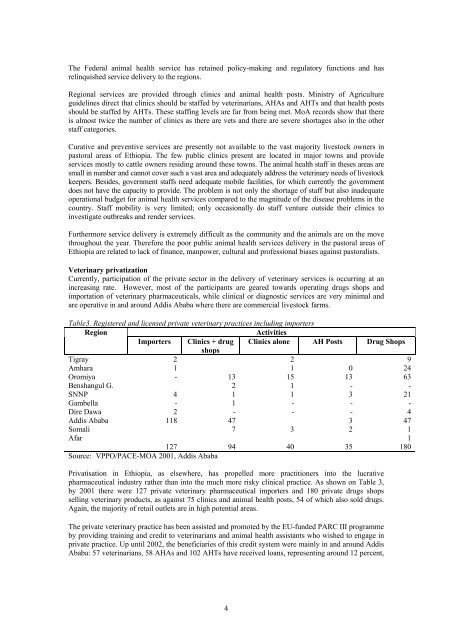Primary Animal Health Care in Ethiopia: The ... - Ethiopian Review
Primary Animal Health Care in Ethiopia: The ... - Ethiopian Review
Primary Animal Health Care in Ethiopia: The ... - Ethiopian Review
Create successful ePaper yourself
Turn your PDF publications into a flip-book with our unique Google optimized e-Paper software.
<strong>The</strong> Federal animal health service has reta<strong>in</strong>ed policy-mak<strong>in</strong>g and regulatory functions and hasrel<strong>in</strong>quished service delivery to the regions.Regional services are provided through cl<strong>in</strong>ics and animal health posts. M<strong>in</strong>istry of Agricultureguidel<strong>in</strong>es direct that cl<strong>in</strong>ics should be staffed by veter<strong>in</strong>arians, AHAs and AHTs and that health postsshould be staffed by AHTs. <strong>The</strong>se staff<strong>in</strong>g levels are far from be<strong>in</strong>g met. MoA records show that thereis almost twice the number of cl<strong>in</strong>ics as there are vets and there are severe shortages also <strong>in</strong> the otherstaff categories.Curative and preventive services are presently not available to the vast majority livestock owners <strong>in</strong>pastoral areas of <strong>Ethiopia</strong>. <strong>The</strong> few public cl<strong>in</strong>ics present are located <strong>in</strong> major towns and provideservices mostly to cattle owners resid<strong>in</strong>g around these towns. <strong>The</strong> animal health staff <strong>in</strong> theses areas aresmall <strong>in</strong> number and cannot cover such a vast area and adequately address the veter<strong>in</strong>ary needs of livestockkeepers. Besides, government staffs need adequate mobile facilities, for which currently the governmentdoes not have the capacity to provide. <strong>The</strong> problem is not only the shortage of staff but also <strong>in</strong>adequateoperational budget for animal health services compared to the magnitude of the disease problems <strong>in</strong> thecountry. Staff mobility is very limited; only occasionally do staff venture outside their cl<strong>in</strong>ics to<strong>in</strong>vestigate outbreaks and render services.Furthermore service delivery is extremely difficult as the community and the animals are on the movethroughout the year. <strong>The</strong>refore the poor public animal health services delivery <strong>in</strong> the pastoral areas of<strong>Ethiopia</strong> are related to lack of f<strong>in</strong>ance, manpower, cultural and professional biases aga<strong>in</strong>st pastoralists.Veter<strong>in</strong>ary privatizationCurrently, participation of the private sector <strong>in</strong> the delivery of veter<strong>in</strong>ary services is occurr<strong>in</strong>g at an<strong>in</strong>creas<strong>in</strong>g rate. However, most of the participants are geared towards operat<strong>in</strong>g drugs shops andimportation of veter<strong>in</strong>ary pharmaceuticals, while cl<strong>in</strong>ical or diagnostic services are very m<strong>in</strong>imal andare operative <strong>in</strong> and around Addis Ababa where there are commercial livestock farms.Table3. Registered and licensed private veter<strong>in</strong>ary practices <strong>in</strong>clud<strong>in</strong>g importersRegionActivitiesImporters Cl<strong>in</strong>ics + drug Cl<strong>in</strong>ics alone AH Posts Drug ShopsshopsTigray 2 2 9Amhara 1 1 0 24Oromiya - 13 15 13 63Benshangul G. 2 1 - -SNNP 4 1 1 3 21Gambella - 1 - - -Dire Dawa 2 - - - 4Addis Ababa 118 47 3 47Somali 7 3 2 1Afar 1127 94 40 35 180Source: VPPO/PACE-MOA 2001, Addis AbabaPrivatisation <strong>in</strong> <strong>Ethiopia</strong>, as elsewhere, has propelled more practitioners <strong>in</strong>to the lucrativepharmaceutical <strong>in</strong>dustry rather than <strong>in</strong>to the much more risky cl<strong>in</strong>ical practice. As shown on Table 3,by 2001 there were 127 private veter<strong>in</strong>ary pharmaceutical importers and 180 private drugs shopssell<strong>in</strong>g veter<strong>in</strong>ary products, as aga<strong>in</strong>st 75 cl<strong>in</strong>ics and animal health posts, 54 of which also sold drugs.Aga<strong>in</strong>, the majority of retail outlets are <strong>in</strong> high potential areas.<strong>The</strong> private veter<strong>in</strong>ary practice has been assisted and promoted by the EU-funded PARC III programmeby provid<strong>in</strong>g tra<strong>in</strong><strong>in</strong>g and credit to veter<strong>in</strong>arians and animal health assistants who wished to engage <strong>in</strong>private practice. Up until 2002, the beneficiaries of this credit system were ma<strong>in</strong>ly <strong>in</strong> and around AddisAbaba: 57 veter<strong>in</strong>arians, 58 AHAs and 102 AHTs have received loans, represent<strong>in</strong>g around 12 percent,4




![to read the full report [pdf, Amharic] - Ethiopian Review](https://img.yumpu.com/52737829/1/190x245/to-read-the-full-report-pdf-amharic-ethiopian-review.jpg?quality=85)











